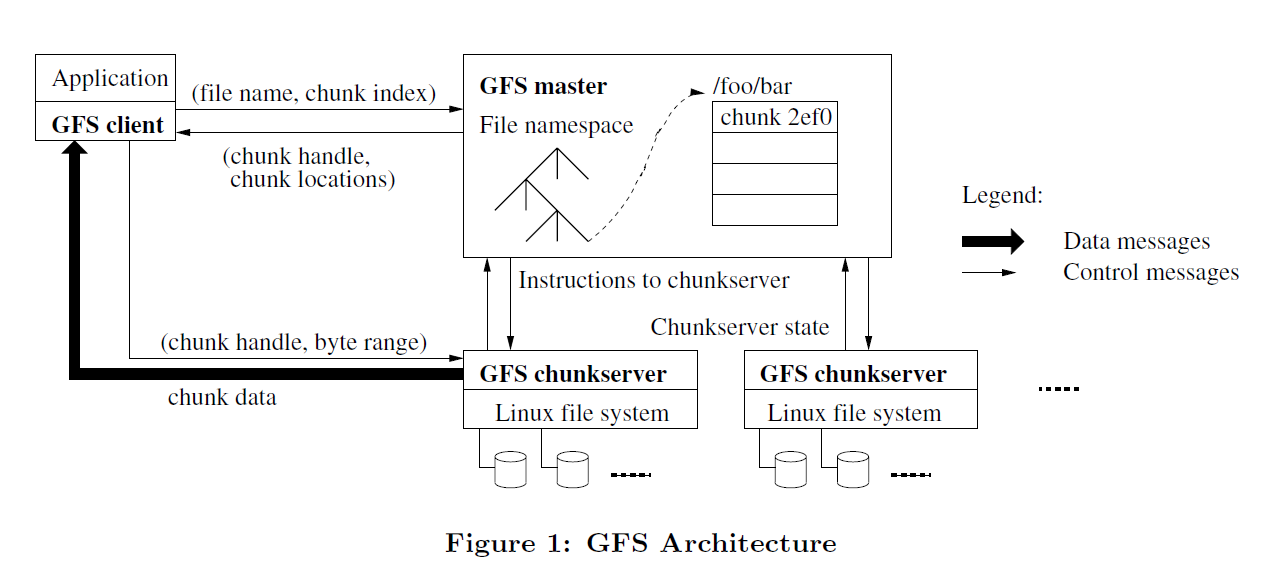GFS 论文阅读
预期背景
Component failures are the norm rather than the exception. So constant monitoring, error detection, fault tolerance, and automatic recovery must be integral to the system.
Files are huge by traditional standards. Multi-GB files are common.
Most files are mutated by appending new data rather than overwriting existing data.
Co-designing the applications and the file system API benefits the overall system by increasing our flexibility.
Architecture

- A GFS cluster consists of a single master and multiple chunkservers and
is accessed by multiple client.
- Files are divided into fixed-size chunks. Each chunk is identified by an
immutable and globally unique 64 bit chunk handle assigned by the master
at the time of chunk creation. Chunkservers store chunks on local disks as
Linux files and read or write chunk data specified by a chunk handle and
byte range. Each chunk is replicated on multiple chunkservers.
- The master maintains all file system metadata. This includes the
namespace, access control infomation, the mapping from files to chunks,
and the current locations of chunks. It also controls system-wide activities
such as chunk lease management, garbage collection of orphaned chunks, and
chunk migration between chunkservers.
- Neither the client nor the chunkserver caches file data.
- for client, that's too big
- for chunkserver, Linux's buffer cache already do this
Single master, to prevent the single master become a bottleneck, clients never read and write file data through the master, instead, a client asks the master which chunkservers it should contact, and it caches this infomation for a limited time and interacts with the chunkservers directly for many subsequent operations.
Chunk Size
A large chunk size offers serveral important advantages.
- Reduces clients' need to interact with the master
- A client is more likely to perform many operations on a given
chunk, it can reduce network overhead by keeping a persistent TCP
connection to the chunkserver over an extended period of time.
- Reduces the size of the metadata stored on the master.
and it’s disadvantage:
- A small file consists of a small number of chunks, perhaps just one, so
it is more likely to become hot spots.
- Metadata
The master stores three major types of metadata:
- The file and chunk namespaces
- The mapping from files to chunks
- The locations of each chunk's replicas
All metadata is kept in the master’s memory. And the first two types(namespaces and the mapping from files to chunks) are also kept persistent by logging mutations to an operation log stored on the master’s local disk and replicated on remote machines. Chunkserver store chunk location infomation, and the master asks every chunkserver for chunk location infomation.
- Chunk Locations. The master does not keep a persistent record of which
chunkservers have a replica of a given chunk, it can keep itself up-to-date
by monitor chunkserver status with regular HeartBeat messages.
- The operation log contains a historical record of critical metadata
changes. So it is central to GFS. Also, it's been kept both in local disk
and remote, and the file size should be small.
- Chunk replicas
Chunk replicas are created for three reasons: chunk creation, re-replication, and rebalancing.
 邮件 订阅
邮件 订阅
 RSS 订阅
RSS 订阅
 Web开发简介系列
Web开发简介系列
 数据结构的实际使用
数据结构的实际使用
 Golang 简明教程
Golang 简明教程
 Python 教程
Python 教程